ISSN
2307–3489 (Print), ІSSN
2307–6666
(Online)
Наука
та прогрес транспорту. Вісник
Дніпропетровського
національного університету залізничного
транспорту, 2016,
№
6
(66)
інформаційно-комунікаційні
технології та математичне моделювання
інформаційно-комунікаційні
технології
та математичне моделювання
UDC
[004.7-047.72]:656.2
V. M. Pakhomovа1*
1*Dep.
«Electronic Computing Machines», Dnipropetrovsk National University
of Railway Transport named after
Academician V. Lazaryan,
Lazaryan St., 2, Dnipro, Ukraine, 49010, tel. +38 (056) 373 15 89,
e-mail viknik.p1988@mail.ru, ORCID 0000-0001-8346-0405
network TRAFFIC forcasting
in
information-telecommunication
system OF prydniprovsk
railwayS
BASED ON
neuro-fuzzy NETWORK
Purpose. Continuous increase
in network traffic in the information-telecommunication system (ITS)
of Prydniprovsk Railways leads to the need
to determine the real-time network congestion and to control the data
flows. One of the possible solutions is a method of forecasting the
volume of network traffic (inbound and outbound) using neural network
technology that will prevent from server overload and improve the
quality of services. Methodology. Analysis
of current network traffic in ITS of Prydniprovsk
Railways and preparation of sets: learning, test and validation ones
was conducted as well as creation of neuro-fuzzy network (hybrid
system) in Matlab program and organization of the following phases on
the appropriate sets: learning, testing, forecast adequacy analysis.
Findings. For the
fragment (Dnipropetrovsk – Kyiv) in ITS
of Prydniprovsk Railways we made a forecast
(day ahead) for volume of network traffic based on the hybrid system
created in Matlab program; MAPE values are as follows: 6.9% for
volume of inbound traffic; 7.7% for volume of outbound traffic. It
was found that the average learning error of the hybrid system
decreases in case of increase in: the number of inputs (from 2 to 4);
the number of terms (from 2 to 5) of the input variable; learning
sample power (from 20 to 100). A significant impact on the average
learning error of the hybrid system is caused by the number of terms
of its input variable. It was determined that the lowest value
of the average learning error is provided by 4-input hybrid system,
it ensures more accurate learning of the neuro-fuzzy network by the
hybrid method. Originality. The
work resulted in the dependences for the average hybrid system error
of the network traffic volume forecasting for the fragment
(Dnipropetrovsk-Kyiv) in ITS Prydniprovsk
Railways on: the number of its inputs, the number of input variable
terms, the learning sample power for different learning methods.
Practical value. Forecasting
of network
traffic volume in
ITS of Prydniprovsk
Railways will allow
for real-time
identification of the network
congestion and
control of data
flows.
Keywords: forecasting, network traffic; volume; neuro-fuzzy
network; hybrid system; term; membership function; set; adequacy;
error
Introduction
To
make a forecast
of the
network traffic
parameters there
are used
various methods
and techniques
that are
widely spread
in the
analysis of
time series
of economic
indicators
[9-10]. In
general, if
the set
 of discrete
values
of discrete
values
 at successive
time points
at successive
time points
 ,
then the
forecasting problem
lies in
forecasting the value
,
then the
forecasting problem
lies in
forecasting the value
 at a
future time
point
at a
future time
point
 .
The forecast usually has an error, but
this error depends on the used forecasting system. High efficiency
of the forecast is achieved with the use of neural networks [1,
11-13]. The forecasting
problem can
be solved
based on
the following
neural networks:
multilayer
perceptron
(MLP), radial
basis function
(RBF),
generalized
regression
neural network
(GRNN), Volterra
networks, Elman
networks and
ANFIS-system,
the overview
of which
is done
in [7].
Fuzzy Neural Networks (hybrid systems) are
designed to combine the advantages of neural networks and fuzzy
inference. They allow
you to
develop and
apply the
models in
the form
of the
rules of fuzzy
production
systems, for the
building of which
the neural
network capabilities
are used
[5]. In
particular, the
adaptive network
of fuzzy
inference
(Adaptive-Network-Based
Fuzzy Inference
System, ANFIS),
which is
implemented in
the Fuzzy
Logic Toolbox
application of
Matlab program
[4]. The main
stages of neuro-fuzzy network operation include: formation of the
rule base of fuzzy inference system; phasing of input variables;
aggregation; activation; accumulation; defuzzification of output
variables, the functioning algorithm of such a system is provided in
[6]. Specifically, [2] proposed a hybrid forecasting system (24
hours ahead) for the suburban passenger flow and [3] formed a hybrid
model for forecasting the wagon loading volume for two previous
days.
.
The forecast usually has an error, but
this error depends on the used forecasting system. High efficiency
of the forecast is achieved with the use of neural networks [1,
11-13]. The forecasting
problem can
be solved
based on
the following
neural networks:
multilayer
perceptron
(MLP), radial
basis function
(RBF),
generalized
regression
neural network
(GRNN), Volterra
networks, Elman
networks and
ANFIS-system,
the overview
of which
is done
in [7].
Fuzzy Neural Networks (hybrid systems) are
designed to combine the advantages of neural networks and fuzzy
inference. They allow
you to
develop and
apply the
models in
the form
of the
rules of fuzzy
production
systems, for the
building of which
the neural
network capabilities
are used
[5]. In
particular, the
adaptive network
of fuzzy
inference
(Adaptive-Network-Based
Fuzzy Inference
System, ANFIS),
which is
implemented in
the Fuzzy
Logic Toolbox
application of
Matlab program
[4]. The main
stages of neuro-fuzzy network operation include: formation of the
rule base of fuzzy inference system; phasing of input variables;
aggregation; activation; accumulation; defuzzification of output
variables, the functioning algorithm of such a system is provided in
[6]. Specifically, [2] proposed a hybrid forecasting system (24
hours ahead) for the suburban passenger flow and [3] formed a hybrid
model for forecasting the wagon loading volume for two previous
days.
Purpose
To develop
the method for forecasting the volume of network traffic (incoming
and outgoing) through the use of neuro-fuzzy network (hybrid system)
for the considered fragment (Dnipropetrovsk-Kyiv) in ITS of
Prydniprovsk
railway.
Problem
statement
Continuous
increase in
network traffic
volume in
ITS of
Prydniprovsk
Railways
requires its
forecasting to
prevent network
congestion and
improve service
quality.
One of the possible solutions can be the
network traffic volume forecasting method that would avoid such an
overload (including that of the server). The study used the real
traffic data of the most important fragment (Dnipropetrovsk
– Kyiv) in ITS of Prydniprovsk
Railways for the period 21.03-26.03.2016. The analysis of inbound
and outbound traffic in the direction of finding long-term
dependency (hours, days) was conducted. For illustrative purposes we
built the charts of network traffic volume for the analyzed ITS
fragment. As an example, Figure 1 shows outbound traffic for
fragment length of 24-hour time series on different days of the
week.
Figure 1
shows the trend of behaviour of the network traffic volume for the
week: it is about the same on Monday, Tuesday, Thursday and Friday;
there are regular changes in a given period. So, in particular, the
traffic volume is lower and more or less stable from 00:00 to 7:00,
significant and unstable traffic from 8:00 to 17:00, and again the
lower and relatively unchanged traffic from 18:00 to 23:00. On
Wednesday the volume of network traffic is the highest, and on
weekends the traffic volume is much lower than on weekdays. The
figure shows that the volume of outbound traffic on Wednesday as
compared to Monday, Tuesday, Thursday and Friday is about 1.3 times
higher. To make a (day ahead) forecast of the network traffic volume
we selected the interval from 8:00 to 17:00, where it has
significant variations, but for weekdays (Monday, Tuesday, Thursday,
Friday) when the nature of traffic is approximately the same. Thus
it was decided to make a (day ahead) forecast of the traffic
volume
x(t)
based on the data of the previous three
days: x(t-1),
x(t-2),
x(t-3).
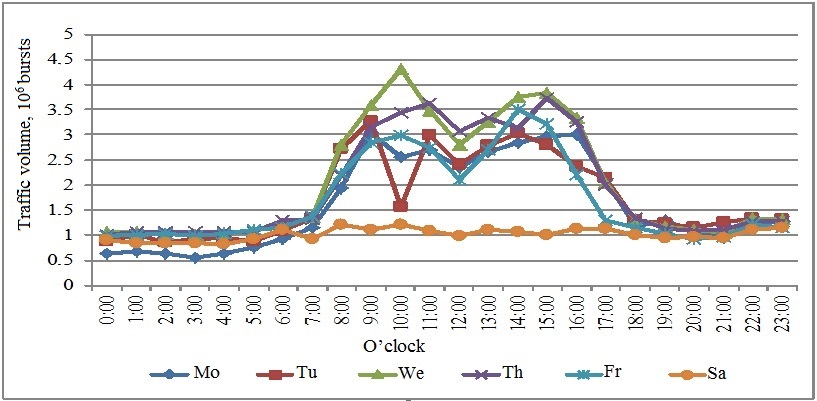
Fig. 1.
Volume of outbound traffic in ITS (Dnipropetrovsk
– Kyiv)
Methodology
1 –
Preparation of sets.
To make
a forecast
it is necessary to
prepare the
following sets:
learning, test,
validation ones.
The prepared set will affect the efficiency of learning and testing
processes, as well as the ability of the network to solve the
problems it faces during operation. To prepare the set we made a
special array of 100 examples close to reality. To form the learning
set the first 50 values of the created array were used while the
other 50 values were used for the test
set. To form a control set we used the
real data of the fourth day, which is not considered.
2 –
Creation
of
neuro-fuzzy
network
in
Matlab.
The task
of forecasting
the traffic
(inbound,
outbound) at
the section
Dnipropetrovsk-Kyiv
is reduced
to the
problem of
time series
forecasting,
usually for
such problems
there is
selected Sugeno
type system.
For the purposes of linguistic assessment each input variable has
two terms (maximum and minimum value), the membership function is
chosen as Gaussian (gaussmf), for assessing the resulting variable
the set membership function is of linear type. In the knowledge-base
editor the set fuzzy inference rules are as follows:
if x(t-1)=min and x(t-2)=min
and x(t-3)=min,
then x(t)=1;
if x(t-1)=min and x(t-2)=min
and x(t-3)=max,
then x(t)=2;
if x(t-1)=min and x(t-2)=max
and x(t-3)=min,
then x(t)=3;
if x(t-1)=min and x(t-2)=max
and x(t-3)=max,
then x(t)=4;
if x(t-1)=max and x(t-2)=min
and x(t-3)=min,
then x(t)=5;
if x(t-1)=max and x(t-2)=min
and x(t-3)=max,
then x(t)=6;
if x(t-1)=max and x(t-2)=max
and x(t-3)=min,
then x(t)=7;
if x(t-1)=max and x(t-2)=max
and x(t-3)=max,
then x(t)=8.
The
structure of the designed fuzzy inference system is shown in Fig. 3.

Fig.
2. Membership function
of the first
input variable
before and after
system learning
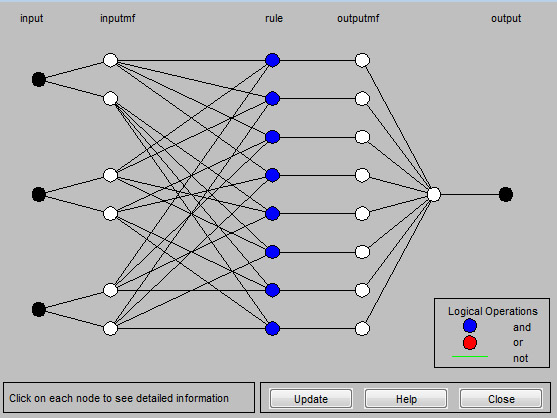
Fig.
3. Structure of the designed hybrid system
As shown in
Fig. 3, the system has 5 layers. The first layer (input) – has
three nodes (х(t–3),
х(t–2),
х(t–1)),
where the input data are conveyed. The
first layer performs dividing phasing of each variable, defining for
each
 -th
rule of
inference of the membership coefficient
according to the applicable phasing
function. The second layer (inputmf)
consists of
-th
rule of
inference of the membership coefficient
according to the applicable phasing
function. The second layer (inputmf)
consists of
 nodes,
because each input variable corresponds to
2 terms, performs
aggregation of individual variables
nodes,
because each input variable corresponds to
2 terms, performs
aggregation of individual variables
 ,
determining the resulting value of the
membership coefficient for vector
,
determining the resulting value of the
membership coefficient for vector
 (the activation level of inference rule);
this layer is nonparametric. The third layer (rule) is TSK function
generator; this is a parametric layer which involves adaptation of
the linear weight determining the function of TSK model inference.
The fourth layer (outputmf)
consists of membership functions for each fuzzy inference rule
(number of nodes of this layer corresponds to the number of rules 23
= 8); this layer is nonparametric. The fifth layer (output) is
normalizing, it has a single node, which corresponds to the output
of the system; this layer is nonparametric.
(the activation level of inference rule);
this layer is nonparametric. The third layer (rule) is TSK function
generator; this is a parametric layer which involves adaptation of
the linear weight determining the function of TSK model inference.
The fourth layer (outputmf)
consists of membership functions for each fuzzy inference rule
(number of nodes of this layer corresponds to the number of rules 23
= 8); this layer is nonparametric. The fifth layer (output) is
normalizing, it has a single node, which corresponds to the output
of the system; this layer is nonparametric.
3 –
Learning of fuzzy neural network.
When learning the hybrid method
(hybrid) was selected as the method of optimization (optim. method),
which combines the least-square method and the reduced reverse
gradient method; the number of iterations of learning (epochs) is
40. As an example, the diagram of membership function of the first
input variable before and after system learning is shown in Fig. 2.
4 –
Testing of hybrid system.
The hybrid
system testing
is conducted on
the test
set. Testing
results as compared to the system learning results are shown in Fig.
4.
5 –
Analysis
of
hybrid
system adequacy.
To assess the quality and accuracy of the forecast of the created
hybrid system we calculated MAPE (Mean Absolute Percentage Error) by
the formula:
 (1)
(1)
where
 – real data at time point t;
– real data at time point t;
 –
predicted data at time point
t; N
– number of hours.
–
predicted data at time point
t; N
– number of hours.
Forecasting
of the network traffic volume was conducted from 8:00 to 17:00
(total hours N = 10). MAPE values are:
6.9% for the forecast of inbound traffic volume, 7.7% for the
forecast of outbound traffic volume. As an example the actual and
predicted volume of outbound traffic in ITS of Dnieper Railways
(Dnipropetrovsk-Kyiv) is shown in Fig. 5.
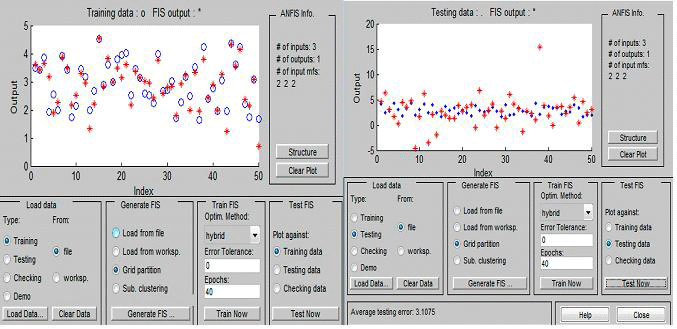
Fig.
4. Results of
learning and
testing
of
neuro-fuzzy
network
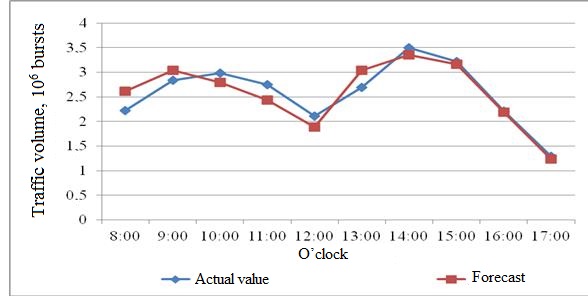
Fig.
5. Actual and predicted volumes of
outbound traffic
Findings
1 – The
study of
dependence of the average
error of the hybrid system learning
on the
number
of
its inputs.
The study involved the average error of the created hybrid system
learning with different number of inputs: 2, 3, 4. In all the
experiments, the length of the learning set was 50 examples, the
number of epochs – 40, system learning
was conducted by hybrid method. The obtained data resulted in the
built diagrams of the dependence of the average error of the hybrid
system learning on the number of its inputs for inbound (outbound)
traffic in ITS of Prydniprovsk
Railways for the considered fragment Dnipropetrovsk-Kyiv and are
presented in Fig. 6.
The
figure shows
that lowest
value of
the average
error of
the hybrid
system learning
is:
0.27∙10-3∙106
= 2.7∙102
bursts for
inbound traffic;
for outbound
traffic is
provided by
4-input hybrid
system at
the learning
set consisted
of 50 examples.
2 – The
study of dependence of the average error of the hybrid system
learning on the number of terms of its input variable.
The study was conducted on the
created hybrid system, which has three input variables; in all the
experiments the length of learning set consisted of 50 examples. Let
us analyse the value of the average error of the hybrid system
learning based on the number of terms of its input variable: 2, 3,
5.
The obtained values resulted in
the built diagrams of the dependence of the average error of the
hybrid system learning on the number of terms of its input variable
by different learning methods that are presented in Fig. 7.
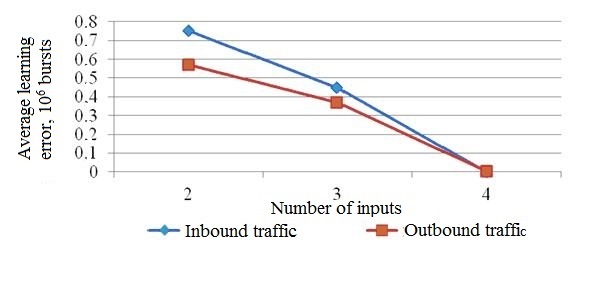
Fig. 6.
Dependence of average error of the hybrid system learning
on the
number of its inputs
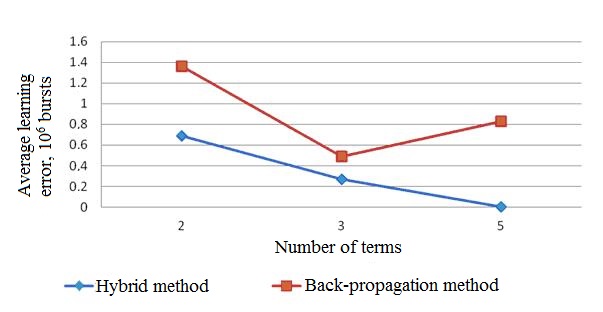
Fig. 7.
Dependence of average error of the hybrid system learning
on the number of terms of its input variable
The
figure shows
that when
the number
of terms
increases (from
2 to 5), the
average error
of the
hybrid system
learning
decreases: from
0.69∙106
to
0.45∙10-5∙106=4.5
bursts by
the hybrid
learning method;
from 1.36∙106
to 0.83∙106
bursts by the
back-propagation
method. Thus,
learning of
the 3-input
hybrid system
(5 terms for
each input
variable) is
more accurate
by the
hybrid method
than by
the
back-propagation
method.
3. The
study of dependence of the average error of the hybrid system
learning on the learning set power.
For the study we took the learning
set of different lengths: 20, 50, 100. The study was conducted on
the hybrid system with three input variables; the learning cycle was
100 epochs. The obtained values resulted in the built diagrams of
the dependence of the average error of the hybrid system learning on
the learning set power according to the learning algorithms that are
presented in Fig. 8.
The figure
shows that when the learning set power increases (20 to 100
examples) onto 3-input hybrid system, its average learning error
decreases: from
0.72∙106
to 0.41∙106
bursts by the hybrid learning method;
from 2.28∙106
to 1.07∙106
bursts by the back-propagation method.
Thus, learning of the hybrid system is more accurate by the hybrid
method at learning set power of 100 examples.
Originality
and practical value
The
originality of the work includes the obtained dependences for the
average hybrid system error of the network traffic volume
forecasting for the fragment (Dnipropetrovsk-Kyiv) in ITS of
Prydniprovsk
Railways on: the number of its inputs, the number of input variable
terms, the learning set power for different learning methods. The
practical value is that forecasting of network traffic volume in ITS
of Prydniprovsk
Railways will allow for real-time identification of the network
congestion and control of data flows.
Conclusions
1. The
work presents the conducted analysis
of the
volume of
network traffic
(inbound and
outbound) in
ITS of
Prydniprovsk
Railways
(Dnipropetrovsk-Kyiv)
based on
the real data.
For forecasting
(day ahead)
the volume of
network traffic
the interval
from 8:00 to
17:00 o’clock was selected,
where there
are significant
variations, but
at that
time of
the week
(Monday,
Tuesday,
Thursday,
Friday) when
the nature
of traffic
is approximately
the same.
2. There
were prepared the learning, test and validation sets based on actual
data for the period 21.03.-26.03.2016. Forecast
of the
network traffic
volume in
ITS of
Prydniprovsk
Railways
(Dnipropetrovsk-Kyiv)
is made
using a
neuro-fuzzy
network (hybrid
system), which
was designed
in Matlab
program. The
hybrid system input is supplied with
the network
traffic volume for the past three days; forecasting of the network
traffic volume was conducted from 8:00 to 17:00 (total hours N =
10); MAPE values are: 6.9% for inbound
traffic; 7.7% for outbound traffic.
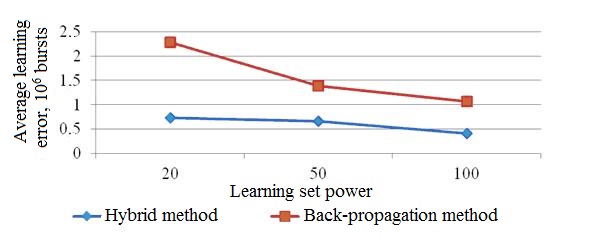
Fig. 8.
Dependence of average error of the hybrid system learning
on the learning set power
3. The
experimental
study was
conducted over
the dependence
of the
average error
of the
hybrid system
learning on:
the number
of its
inputs (first
study), the
number of
input variable
terms (second
study), the
learning set
power (third
study) by
different
learning methods:
hybrid,
back-propagation.
Significant impact on the average error of
the hybrid system learning has the number of input variable terms.
In ITS of Prydniprovsk
Railways (Dnipropetrovsk-Kyiv):
– The
first study
showed that
the most
accurate volume
forecast of
the inbound
traffic
(learning error
2.7∙102)
and outbound
traffic
(learning error
19∙102)
is achieved
with 4-input
hybrid system
at the
length of
the learning
set of
50 examples;
– The
results of
the second
study showed
that increase
in the
number of
terms (from
2 to 5) of
its input
variable leads
to decrease
in the
average learning
error: from
0.69∙106
to 4.5 bursts
by the
hybrid method;
from 1.36∙106
to 0.83∙106
bursts by
back-propagation
method. Thus,
learning of
the 3-input
hybrid system
that has
5 terms for
each input
variable, is
more accurate
by the
hybrid method;
– The
results of
the third
study showed
that increase
in the
learning set
power (from
20 to 100
examples) onto
3-input hybrid
system leads
to decrease
in the
average learning
error: from
0.72∙106 to
0.41∙106
bursts by
the hybrid
method; from
2.28∙106 to
1.07∙106
bursts by
the
back-propagation
method. Thus,
the learning
is more
accurate by
the hybrid
method at
the learning
set power
of 100 examples.
LIST OF REFERENCE LINKS
Герасина,
А. В. Адаптивное нечеткое прогнозирование
трафика в информационных телекоммуникационных
сетях / А. В. Герасина //
Системи обробки інформації : зб. наук.
пр. / Харк. ун-т повітр. сил ім. Івана
Кожедуба. – Харків, 2013. – Вип. 9
(116). – С. 141–145.
Константінов,
Д. В. Формування адаптивної технології
приміських залізничних перевезень :
автореф. дис. … канд. техн. наук : 05.22.01
/ Константінов Денис Володимирович ;
Укр. держ. акад. залізн. трансп. – Харків,
2010. – 20 с.
Костєнніков,
О. М. Удосконалення технології формування
місцевого вагонопотоку на дільниці в
умовах сезонного коливання обсягів
навантаження : автореф. дис. … канд.
техн. наук : 05.22.01 / Костєнніков Олексій
Михайлович ; Укр. держ. акад. залізн.
трансп. – Харків, 2012. – 20 с.
Леоненков,
А. В. Нечеткое моделирование в среде
MatLAB и fuzzy TECH / А. В. Леоненков. –
Санкт-Петербург : БХВ-Петербург, 2003. –
736 с.
Манусов,
В. З. Краткосрочное прогнозирование
электрической нагрузки на основе
нечеткой нейронной сети и ее сравнение
с другими методами / В. З. Манусов, Е. В.
Бирюков. – Изв.
Томск. политехн. ун-та. – 2006. – Т.
309, № 6. – С. 153–158.
Мещеряков,
В. А. Моделирование адаптивной системы
нейронечеткого управления рабочим
процессом стрелового крана / В. А.
Мещеряков, И. В. Денисов // Проектирование
инженер. и науч. приложений в среде
MatLAB : материалы V Междунар. науч. конф.
– Харьков, 2011. – С. 367–375.
Пахомова,
В. М. Розробка підсистеми оперативного
прогнозування простоїв прибуваючих
поїздів на основі ANFIS-системи / В. М.
Пахомова, С. Ю. Дмітрієв // Інформ.-керуючі
системи на залізн. трансп. – 2013. – №
4. – С. 46–55.
Пахомова,
В. М. Дослідження інжинірингу трафіка
в комп’ютерній мережі УЗ за технологією
MPLS TE
/ В. М. Пахомова // Наука
та прогрес транспорту. – 2015. – № 1 (55).
– C.
139–147. doi:
10.15802/STP2015/38262.
Покровская,
М. А. Метод прогнозирования
изменения трафика с использованием
нейросетевой модели / М. А. Покровськая
// T-Comm – Телекоммуникации и Транспорт.
– 2012. – № 6. –
С. 27–30.
Сравнительный
анализ методов прогнозирования трафика
в телекоммуникационных системах
[Electronic
resource] / К.
М. Руккас, Ю. В. Соляник, К. А. Овчинников,
О. О. Давид // Проблемы телекоммуникаций.
– 2014. – № 1 (13). – С. 84–95. – Available
at:
http://pt.journal.kh.ua/2014/1/1/141_rukkas_analysis.pdf.
– Title from
the screen.
– Accessed :
22.11.16.
Chabaa, S.
Identification and prediction of internet traffic using artificial
neural networks / S. Chabaa, A. Zeroual, J. Antari // J. of
Intelligent Learning Systems and Applications. – 2010. – Vol.
02. – Iss. 03. – P. 147–155. doi: 10.4236/jilsa.2010.23018.
Gowrishankar,
S. A time series modeling and prediction of wireless network
traffic / S. Gowrishankar, P. S. Satyanarayana // Intern. J. of
Interactive Mobile Technologies (iJIM). – 2009. – Vol. 3. –
Iss. 1. – P. 53–62. doi: 10.3991/ijim.v3i1.284.
Multi-scale
Internet traffic forecasting using neural networks and time series
methods / P. Cortez, M. Rio, M. Rocha, P. Sousa // Expert Systems.
– 2010. – Vol. 29. – Iss. 2. – P. 143–155. doi:
10.1111/j.1468-0394.2010.00568.x.
В. М. ПАХОМОВА1*
1*Каф. «Електронні
обчислювальні машини», Дніпропетровський
національний університет залізничного
транспорту імені академіка В. Лазаряна,
вул. Лазаряна, 2, Дніпро, Україна, 49010,
тел. +38 (056) 373 15 89,
ел.
пошта viknik.p1988@mail.ru, ORCID
0000-0001-8346-0405
ПРОГНОЗУВАННЯ ОБСЯГУ
МЕРЕЖЕВОГО ТРАФІКа
В
ІНФОРМАЦІЙНО-ТЕЛЕКОМУНІКАЦІЙНІЙ
СИСТЕМІ
ПРИДНІПРОВСЬКОЇ ЗАЛІЗНИЦІ НА
ОСНОВІ
НЕЙРОНЕЧІТКОЇ
МЕРЕЖІ
Мета. Постійне
збільшення обсягу мережного трафіка
в інформаційно-телекомунікаційній
системі (ІТС) Придніпровської залізниці
призводить до
необхідності
визначення в реальному
часі перевантаження в мережі та
здійснення контролю потоків даних.
Одним із можливих рішень є метод
прогнозування обсягу мережного трафіка
(вхідного та вихідного) з використанням
нейромережної технології, що дозволить
уникнути перевантаження сервера та
підвищити якість послуг.
Методика.
В роботі виконані аналіз існуючого
мережного трафіка в ІТС Придніпровської
залізниці та підготовка
вибірок: навчальної, тестової, контрольної,
а також створення в програмі Matlab
нейронечіткої мережі (гібридної системи)
та організація на відповідних вибірках
таких етапів: навчання, тестування,
аналіз адекватності прогнозу.
Результати. Для фрагмента
(Дніпропетровськ – Київ)
в ІТС Придніпровської
залізниці здійснений
прогноз (на добу вперед)
обсягу мережного трафіка на основі
гібридної системи, що створена в програмі
Matlab; значення MAPE
складає: 6,9 % для обсягу вхідного трафіка;
7,7 % для обсягу вихідного трафіка.
Виявлено, що середня похибка навчання
гібридної системи зменшується при
збільшенні: кількості входів (від 2 до
4); кількості термів (від 2 до 5) вхідної
змінної; потужності навчальної вибірки
(від 20 до 100). Значний вплив на середню
похибку навчання гібридної системи
має кількість термів її вхідної змінної.
Визначено, що найменше
значення середньої похибки навчання
надає чотири-вхідна гібридна система,
більш точно здійснюється
навчання нейронечіткої
мережі за гібридним
методом. Наукова новизна.
Отримані залежності
середньої похибки навчання гібридної
системи прогнозування обсягу мережного
трафіка фрагмента (Дніпропетровськ–Київ)
в ІТС Придніпровської залізниці від:
кількості її входів, кількості термів
вхідної змінної, потужності навчальної
вибірки за різними методами навчання.
Практична значимість.
Прогнозування обсягу
мережного трафіка в ІТС
Придніпровської залізниці
дозволить в реальному
часі визначити перевантаження в мережі
та здійснити контроль потоків даних.
Ключові слова: прогнозування;
мережний трафік; обсяг; нейронечітка
мережа; гібридна система; терм; функція
приналежності; вибірка; адекватність;
похибка
В. Н. ПАХОМОВА1*
1*Каф.
«Электронные вычислительные машины»,
Днепропетровский национальный
университет
железнодорожного
транспорта имени академика В. Лазаряна,
ул. Лазаряна, 2, Днипро, Украина, 49010,
тел. +38 (056) 373 15 89, эл. почта
viknik.p1988@mail.ru, ORCID
0000-0001-8346-0405
ПРОГНОЗИРОВАНИЕ ОБЪЕМА СЕТЕВОГО
трафИка
в ИНФОРМАЦИОННО-ТЕЛЕКОММУНИКАЦИОННОЙ
СИСТЕМЕ ПРИДНЕПРОВСКОЙ ДОРОГИ НА ОСНОВЕ
НЕЙРОНЕЧЕТКОЙ СЕТИ
Цель.
Постоянное увеличение
объема сетевого трафика в
информационно-телекоммуникационной
системе (ИТС) Приднепровской железной
дороги приводит к необходимости
определения в реальном времени перегрузки
в сети и осуществления контроля потоков
данных. Одним из возможных решений
является метод прогнозирования объема
сетевого трафика (входного и выходного)
с использованием нейросетевой технологии,
что позволит избежать перегрузки
сервера и повысить качество услуг.
Методика. В
работе проведены анализ
существующего сетевого трафика в ИТС
Приднепровской железной дороги и
подготовка выборок: учебной, тестовой,
контрольной, а также создание в программе
Matlab нейронечеткой сети
(гибридной системы) и организация на
соответствующих выборках следующих
этапов: обучение, тестирование, анализ
адекватности прогноза.
Результаты. Для фрагмента
(Днепропетровск–Киев)
в ИТС
Приднепровской железной дороги
осуществлен прогноз (на сутки вперед)
объема сетевого трафика на основе
гибридной системы, созданной в программе
Matlab; значение MAPE
составляет: 6,9 % для объема входящего
трафика; 7,7 % для объема выходящего
трафика. Выявлено,
что средняя ошибка обучения гибридной
системы уменьшается при увеличении:
количества входов (от 2 до 4); количества
термов (от 2 до 5) входной переменной;
мощности обучающей выборки (от 20 до
100), большое влияние на среднюю ошибку
обучения гибридной системы оказывает
число термов ее входной переменной.
Определено, что
наименьшее значение ошибки обучения
дает 4-входная гибридная система, более
точно осуществляется обучение
нейронечеткой сети по гибридному
методу. Научная новизна.
Получены зависимости
средней ошибки обучения гибридной
системы прогнозирования объема сетевого
трафика фрагмента (Днепропетровск –
Киев) в ИТС Приднепровской дороги от:
количества входов, количества термов
входной переменной, мощности обучающей
выборки при различных методах обучения.
Практическая значимость.
Прогнозирование объема
сетевого трафика в ИТС Приднепровской
дороги позволит в реальном времени
определить перегрузки в сети и осуществить
контроль потоков данных.
Ключевые слова: прогнозирование;
сетевой трафик; объем; нейронечеткая
сеть; гибридная система; терм; функция
принадлежности; выборка; адекватность;
ошибка
REFERENCES
Gerasina A.V. Adaptivnoye nechetkoye
prognozirovaniye trafika v informatsionnykh telekommunikatsionnykh
setyakh [Adaptive fuzzy prediction of traffic in information and
telecommunication networks]. Systemy obrobky informatsii
– Information Processing Systems, 2013, issue 9 (116), pp.
141-145.
Konstantinov
D.V. Formuvannia adaptyvnoi
tekhnolohii prymiskykh zaliznychnykh perevezen.
Avtoreferat Diss.
[Formation of adaptive technology of
commuter rail transportation. Author’s
abstract]. Kharkiv, 2010.
20 p.
Kostiennikov
O.M. Udoskonalennia tekhnolohii
formuvannia mistsevoho vahonopotoku na dilnytsi v umovakh
sezonnoho kolyvannia obsiahiv navantazhennia.
Avtoreferat Diss.
[Improving the technology of forming a
local car traffic volume at
the section in
terms of seasonal fluctuations in load.
Author’s
abstract].
Kharkiv, 2012. 20 p.
Leonenkov
A.V. Nechetkoye
modelirovaniye
v srede MatLAB i fuzzy TECH [Fuzzy
modeling in MatLAB and fuzzy TECH environment].
Saint-Petersburg,
BKhV-Peterburg Publ., 2003. 736 p.
Manusov
V.Z., Biryukov Ye.V. Kratkosrochnoye prognozirovaniye
elektricheskoy nagruzki na osnove nechetkoy neyronnoy seti i yeye
sravneniye s drugimi metodami [Short-term forecasting of electric
load based on fuzzy neural network and its comparison with other
methods]. Izvestiya Tomskogo
politekhnicheskogo universiteta – Bulletin of the Tomsk
Polytechnic University, 2006, vol.
309, no. 6, pp. 153-158.
Meshcheryakov
V.A.,
Denisov I.V.
Modelirovaniye
adaptivnoy
sistemy
neyronechetkogo
upravleniya
rabochim
protsessom
strelovogo
krana [Adaptive
system modeling
of neuro-fuzzy control
of operational process for jib
crane.]. Materialy
V
Mezhdunarodnoy
nauchnoy
konferentsii
«Proyektirovaniye
inzhenernykh
i
nauchnykh
prilozheniy
v
srede
MatLAB»
[Proc. of
Vth
Intern. Sci. Conferernce «Design of
Engineering and Scientific
Applications in
Matlab Environment»].
Kharkov, 2011,
pp. 367-375.
Pakhomova
V.M., Dmitriiev S.Yu. Rozrobka pidsystemy operatyvnoho
prohnozuvannia prostoiv prybuvaiuchykh poizdiv na osnovi
ANFIS-systemy [Subsystem
development of operational forecasting of
inactive coming trains based
on ANFIS-system]. Informatsiino-keruiuchi
systemy na zaliznychnomu transporti – Information and
Control Systems
at
Railway
Transport,
2013, no.
4, pp. 46-55.
Pakhomova
V.M. Doslidzhennia inzhynirynhu trafika v kompiuternii merezhi UZ
za tekhnolohiieiu MPLS TE [Research of engineering traffic in
computer of Ukrzaliznytsia network using MPLS TE technology]. Nauka
ta prohres transportu – Science and Transport Progress,
2015, no. 1 (55), pp. 139-147. doi: 10.15802/stp2015/3826.
Pokrovskaya
M.A. Metod prognozirovaniya izmeneniya trafika s ispolzovaniyem
neyrosetevoy modeli [Prediction method of
traffic change with the use of neural network model].
T-Comm – Telekommunikatsii i
Transport – T-Comm – Telecommunications and Transport,
2012, vol. 6,
no. 6, pp.
27-30.
Rukkas
K.M., Solyanik Yu.V., Ovchinnikov K.A., David O.O. Sravnitelnyy
analiz metodov prognozirovaniya trafika v telekommunikatsionnykh
sistemakh (Comparative
analysis of traffic
prediction
techniques in
telecommunication systems).
Problemy telekommunikatsiy –
Problems of Telecommunications,
2014, no.
1 (13), pp.
84-95.
Available at:
http://pt.journal.kh.ua/2014/1/1/141_rukkas_analysis.pdf
(Accessed 22 November 2016).
Chabaa
S., Zeroual A., Antari J. Identification and prediction of internet
traffic using artificial neural networks. Journal
of Intelligent Learning Systems and Applications,
2010, vol. 02, issue 03, pp. 147-155. doi:
10.4236/jilsa.2010.23018.
Gowrishankar
S., Satyanarayana P.S. A time series modeling and prediction of
wireless network traffic. Intern.
Journal of Interactive Mobile Technologies (iJIM),
2009, vol. 3, issue 1, pp. 53-62. doi: 10.3991/ijim.v3i1.284.
Cortez
P., Rio M., Rocha M., Sousa P. Multi-scale internet traffic
forecasting using neural networks and time series methods. Expert
Systems, 2010, vol. 29, no. 2,
pp. 143-155. doi: L10.1111/j.1468-0394.2010.00568.x.
Prof. V. V. Tkachov, D. Sc.
(Tech.) (Ukraine); Prof. V. V. Skalozub, D. Sc. (Tech.) (Ukraine)
recommended this article to be published
Accessed: Sep. 26, 2016
Received: Dec. 05, 2016
doi ©
V. M. Pakhomova, 2016
of discrete
values
at successive
time points
,
then the
forecasting problem
lies in
forecasting the value
at a
future time
point
.
The forecast usually has an error, but
this error depends on the used forecasting system. High efficiency
of the forecast is achieved with the use of neural networks [1,
11-13]. The forecasting
problem can
be solved
based on
the following
neural networks:
multilayer
perceptron
(MLP), radial
basis function
(RBF),
generalized
regression
neural network
(GRNN), Volterra
networks, Elman
networks and
ANFIS-system,
the overview
of which
is done
in [7].
Fuzzy Neural Networks (hybrid systems) are
designed to combine the advantages of neural networks and fuzzy
inference. They allow
you to
develop and
apply the
models in
the form
of the
rules of fuzzy
production
systems, for the
building of which
the neural
network capabilities
are used
[5]. In
particular, the
adaptive network
of fuzzy
inference
(Adaptive-Network-Based
Fuzzy Inference
System, ANFIS),
which is
implemented in
the Fuzzy
Logic Toolbox
application of
Matlab program
[4]. The main
stages of neuro-fuzzy network operation include: formation of the
rule base of fuzzy inference system; phasing of input variables;
aggregation; activation; accumulation; defuzzification of output
variables, the functioning algorithm of such a system is provided in
[6]. Specifically, [2] proposed a hybrid forecasting system (24
hours ahead) for the suburban passenger flow and [3] formed a hybrid
model for forecasting the wagon loading volume for two previous
days.